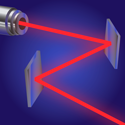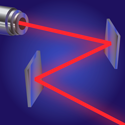Describing the interaction of light with matter, big and small
Cooling, trapping, and manipulating matter with light are some of the main tools for experimental atomic and molecular physics. For example, the laser cooling of atoms is a prerequisite to Bose-Einstein condensation and other cold-atom experiments, while so-called “optical lattices” are used to arrange atoms and can mimic the behavior of condensed matter systems. More recently, the emerging field of optomechanics, which relies on manipulating macroscopic objects such as micromechanical mirrors with light, has gained considerable attention.
Up to now, theorists have relied on different approaches for describing these two very distinct scenarios—the cooling of a weakly scattering atom versus that of a strongly scattering object like a mirror. Writing in Physical Review A, André Xuereb, Peter Horak, and Tim Freegarde from the University of Southampton in the UK, together with Peter Domokos and János Asbóth from the Hungarian Academy of Sciences, develop a scattering formalism for general optomechanical systems consisting, in principle, of arbitrary combinations of atoms and mirrors interacting through the radiation field. The approach is a generalization of the well-known transfer matrix method, which relates forward- and backward-going waves on both sides of an optical element, allowing for moving scatterers. Xuereb et al.’s formalism provides a powerful and unified framework for treating optomechanical systems that encompasses both limits of atoms and moving mirrors, and will allow for the description of more complex cases that combine different optical and mechanical elements. – Thomas Pattard





